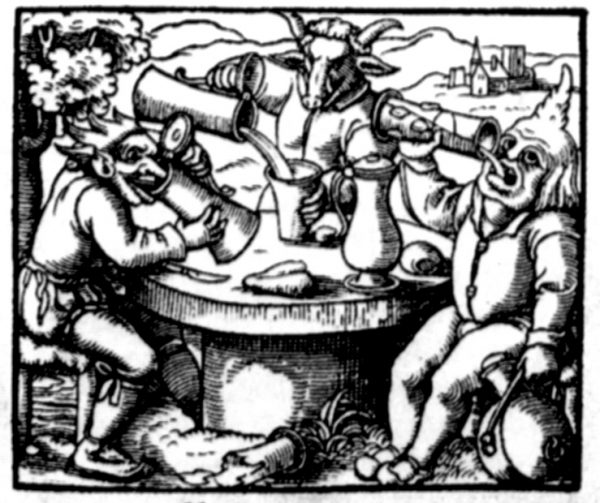
Matthäus Fridrich: Wider die(?)/den(?) Sauffteuffel, 1562 (Prädikantenbibliothek Isny)
On August 15, 1890, American biostatistician and physiologist E. Morton Jellinek was born. Jellinek was a pioneer in the scientific study of the nature and causes of alcoholism and in descriptions of its symptomatology. He was an early proponent of the disease theory of alcoholism, arguing with great persuasiveness that alcoholics should be treated as sick people.
Youth and Education
Born in New York City, USA, Jellinek studied biostatistics and physiology at the University of Berlin from 1908 to 1910. From 1910-1911, he continued his studies of philosophy, philology, anthropology, and theology at the Joseph Fourier University in Grenoble, France. He was also enrolled, apparently concurrently, at the University of Leipzig from 25 November 1911 to 29 July 1913, and from 22 November 1913 to 2 December 1914 for classes in languages, linguistics as well as cultural history. He received a Master of Education degree at the University of Leipzig in 1914. He returned to Leipzig in 1935 and was awarded the degree of Doctor of Science. However, there has been a dispute whether Jellinek really did hold a PhD since there exist no records at the University of Leipzig [3].
During the 1920s, he conducted research in Sierra Leone and at Tela, Honduras. In the 1930s he returned to the U.S.A. and worked at the Worcester State Hospital, Worcester, Massachusetts, from whence he was commissioned to conduct a study for the Research Council on Problems of Alcohol. The eventual outcome of his study was the 1942 book, Alcohol Addiction and Chronic Alcoholism.
Research in Alcoholism
In 1849, the Swedish Physician Magnus Huss was the first to systematically classify the damage that was attributable to alcohol ingestion. Huss coined the term alcoholism and used it to label what he considered to be a chronic, relapsing disease. Jellinek coined the expression “the disease concept of alcoholism“, and significantly accelerated the movement towards the medicalization of drunkenness and alcohol habituation. Jellinek’s initial study was based on a narrow, selective study of a hand-picked group of members of Alcoholics Anonymous who had returned a self-reporting questionnaire.
The Five Types of Alcoholism
In his 1960 book “The Disease Concept of Alcoholism” he identified five different types of alcoholism, and defined them in terms of their abnormal physiological processes:
- Alpha alcoholism: the earliest stage of the disease, manifesting the purely psychological continual dependence on the effects of alcohol to relieve bodily or emotional pain. This is the “problem drinker”, whose drinking creates social and personal problems. Whilst there are significant social and personal problems, these people can stop if they really want to; thus, argued Jellinek, they have not lost control, and as a consequence, do not have a “disease”.
- Beta alcoholism: polyneuropathy, or cirrhosis of the liver from alcohol without physical or psychological dependence. These are the heavy drinkers that drink a lot, almost every day. They do not have physical addiction and do not suffer withdrawal symptoms. This group do not have a “disease”.
- Gamma alcoholism: involving acquired tissue tolerance, physical dependence, and loss of control. This is the AA alcoholic, who is very much out of control, and does, by Jellinek’s classification, have a “disease”.
- Delta alcoholism: as in Gamma alcoholism, but with inability to abstain, instead of loss of control.
- Epsilon alcoholism: the most advanced stage of the disease, manifesting as dipsomania, or periodic alcoholism.
The “Jellinek curve” is derived from this classification of Morton Jellinek, and it was named out of respect for Jellinek’s work.
The Placebo Effect
From 1941 to 1952, Jellinek was Associate Professor of Applied Physiology at Yale University. In 1952 he was engaged by the World Health Organization in Geneva as a consultant on alcoholism, and made significant contributions to the work of the alcoholism sub-committee of the W.H.O.’s Expert Committee on Mental Health. In post-war 1946, pharmaceutical chemicals were in short supply. A headache remedy manufacturer asked Jellinek, then at Yale, to test whether the absence of that particular chemical would affect the drug’s efficacy in any way. Morton Jellinek set up a complex trial – with 199 subjects, divided randomly into four test groups – involving various permutations of the three drug constituents, with a placebo as a scientific control. Each group took a test remedy for two weeks. The trial lasted eight weeks, by the end of which each group had taken each test drugs, albeit in a different sequence. Over the entire population of 199 subjects, 120 of the subjects responded to the placebo, and 79 did not. The trial demonstrated that the chemical in question significantly contributed to the remedy’s efficacy.
Upon his retirement from the W.H.O. in the late 1950s, he returned to the USA. In 1958 he joined the Psychiatry Schools of both the University of Toronto and the University of Alberta, and in 1962, he moved to Stanford University in California, where he remained until his death in 1963.
Marc Lewis, The Neuroscience of Addiction [6]
References and Further Reading:
- [1] E. Morton Jellinek, Obituary, The American Journal Of Psychiatry, Vol. 120, No. 12, June, 1964
- [2] E.M. Jellinek on Alcoholism
- [3] Ron Roizen, Jellinek’s Phantom Doctorate, 1997
- [4] Jellinek, E.M., “Phases of Alcohol Addiction,” Quarterly Journal of Studies on Alcohol 13:673-684, 1952.
- [5] E. Morton Jelinek at Wikidata
- [6] Marc Lewis, The Neuroscience of Addiction, The Royal Institution @ youtube
- [7] Falcone, T.J., “Alcoholism: A Disease of Speculation“, Baldwin Research Institute, 2003.
- [8] Greenberg, G., “The Creation of Disease”, The New Yorker, April 20, 2013
- [9] Timeline of E. Morton Jelinek, created via Wikidata





